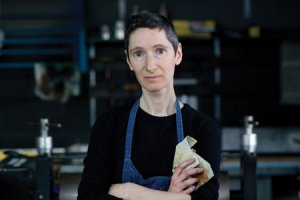 Victoria Goro-Rapoport
Victoria Goro-Rapoport
Associate Professor of Art
Printmaking: is it an art, or is it a science? It’s a common debate in academia and the arts communities, but a debate that international-award winning printmaker Victoria Goro-Rapoport is at peace about, because she lives and works the answer to that question every day in her studio and classroom.
Her “peace” with this debate may also derive, in part, from the national and international success of her work. Of the numerous recognitions her work has achieved, one of the most prestigious is having had her works included in The Big Book, a catalog of the Miedzynarodowe Triennale Grafiki (International Print Triennial) in Krakow, Poland, an international printed art exhibition.
Since coming to UNK in 2004, her prints have been featured in more than 130 juried national and international exhibitions, and she has won six Solo Exhibition Awards. In the last four years, alone, she has won 49 national awards (15 for Best of Show or First Place) and 11 international awards. Acceptance into juried exhibitions is highly competitive. Of the national juried exhibitions, 10 of those selected only 10 percent of the entries, and two of the international exhibitions selected fewer than 5 percent and 7.5 percent of the entries, respectively.
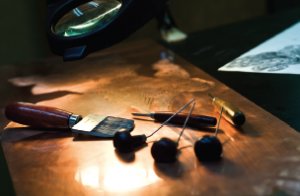 Although her work is highly acclaimed, both nationally and internationally, the Russian-born Goro-Rapoport talks in matter-of-fact terms about her art and her colleagues. “Being artists, we are sort of on the fringe of academia. In Russia that’s how it was. There were art schools. And there were universities. But,” she continues, “just like scientists, while executing my work, I strive to understand the world and how it works.”
Although her work is highly acclaimed, both nationally and internationally, the Russian-born Goro-Rapoport talks in matter-of-fact terms about her art and her colleagues. “Being artists, we are sort of on the fringe of academia. In Russia that’s how it was. There were art schools. And there were universities. But,” she continues, “just like scientists, while executing my work, I strive to understand the world and how it works.”
This approach is evident in her teaching as well. Students tell her over and over, “I never thought art could involve so much thinking.”
“I teach art, scientifically,” Goro-Rapoport said. “We take deliberate, methodical steps in the creation of a piece. Observe. Analyze data. Transfer information into an artful piece. We measure the proportion relationships of the objects and their parts. We analyze the varying value relationships and intensity of light within a piece.”
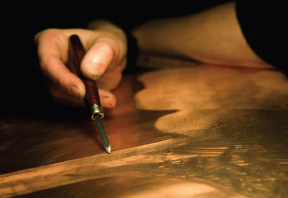 The connection of art to nature, Goro-Rapoport shares, is so strong that its connection to science is undeniable. “Art, especially in the Renaissance with artist-scientist figures like da Vinci, has always highlighted the organic relationship between liberal sciences and liberal arts. Drawing is very much mathematics. She regards the Process (with a capital “P”) as not much different from that when the laboratory technician “looked through a microscope or split the atom.”
The connection of art to nature, Goro-Rapoport shares, is so strong that its connection to science is undeniable. “Art, especially in the Renaissance with artist-scientist figures like da Vinci, has always highlighted the organic relationship between liberal sciences and liberal arts. Drawing is very much mathematics. She regards the Process (with a capital “P”) as not much different from that when the laboratory technician “looked through a microscope or split the atom.”
Beyond the Art vs. Science model, dualism seems to be a recurring theme for Goro-Rapoport in this activity that serves her as both livelihood and absorbing leisure. Old vs. New, industrially– speaking. Traditional vs. Technological—production-wise. Human vs. Machine. Teaching vs. Creating. Natural Talent vs. Honed Skill. Remarkably, Goro-Rapoport has created her own alphabet, she says to help her clarify in her own mind, and then express this constant theme of biformity that seems to parallel her life. Her alphabet can be detected in many of her pieces. “I am a child of two countries. I think there will always be that dualism of where I am and the question of ‘Where Am I?’” This is the creative, ever-searching world of Victoria Goro-Rapoport. Yet, emphatically, when forced to definitively label herself, she confidently states, “I am an artist. I am a printmaker.”
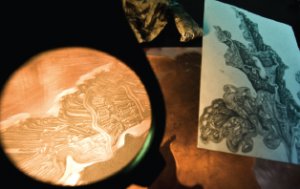 As a child in Russia, Goro-Rapoport began attending a special arts school three days a week, for four hours each, in addition to a regular school day in the country’s traditional elementary/secondary system. She was required to pass entrance exams for this privilege, and she maintained this schedule for eight years. In 1990, at the age of 24, just as the Soviet Union was dissolving, she decided to emigrate. “There was a kind of hysteria going on in Russia then,” she recalls vividly. “It was time to get out.”
As a child in Russia, Goro-Rapoport began attending a special arts school three days a week, for four hours each, in addition to a regular school day in the country’s traditional elementary/secondary system. She was required to pass entrance exams for this privilege, and she maintained this schedule for eight years. In 1990, at the age of 24, just as the Soviet Union was dissolving, she decided to emigrate. “There was a kind of hysteria going on in Russia then,” she recalls vividly. “It was time to get out.”
Because she is part Jewish, she was allowed to emigrate to Israel. She spent four years there during which time she opened up a framing shop and established business relationships with the Jerusalem Printmaking Workshop/Studio Sadnat-ha-Hedpes. This daily exposure led her to begin taking classes in printmaking. Eventually, she wanted to be in closer proximity to her parents – her mother was teaching chemistry at the University of Utah in Salt Lake City. Goro-Rapoport joined her parents there. She worked in theatre and earned a master’s degree in set design (the discipline of her bachelor’s degree). She went on to the University of Illinois at Urbana Champaign where she finished a degree in printmaking and taught for two years. “While my early years of education were more classically-oriented,” Goro- Rapoport said, “the emphasis was mostly on traditional academic drawing and painting. This gave me a solid professional background necessary for teaching drawing and printmaking.”
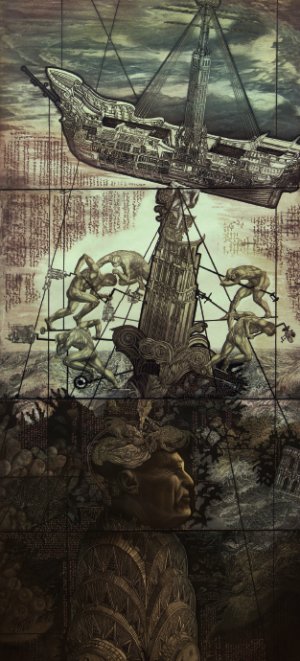
A significant indication of impact and professional success in Goro-Rapoport’s field is “getting into the International Print Triennial (The Big Book) in Krakow. I personally consider the Krakow Triennial a very important show, not only because it is the biggest international show I am aware of, with the competition being very fierce, but also because it is one of the few shows that embraces Western as well as East European and Eastern traditions, without being biased to either.”
In 2000, while still a first year graduate student, three of her small engravings were accepted into The Big Book. In 2003, two of her prints, titled “Jacob’s Ladder” and “Adam’s Vision,” appeared in Miedzynarodowe Triennale Grafiki. Three years later, her “Stepping Out” and “Sinking of the Empire” pieces were accepted. And she has just been notified that two prints have been accepted for the 2009 exhibition.
Keeping her set design background in mind, Goro-Rapoport’s prints have been described as theatrical. Clearly, the interpretations of her mind’s eye are richly-influenced by both mythological and Biblical images. Prominent in most of her designs are the combined themes of history and modernity—specifically, the clashing antagonism but also interdependence of the two. In many of Goro-Rapoport’s images, one detects human figures being devoured by monstrous, intricate steel buildings. “In these scenes of a human figure in an industrial environment, I am asking the question of ‘Who controls whom?’” Goro-Rapoport explains. “To some degree, I think we regard the new as good and the old as not as important. I think we lose a lot when we do this. I prefer to explore the implications of their coexistence.”
Her work is partly inspired by the experiences she had living in big cities. There, she was surrealistically conscious of the human bustle buttressed against massive buildings going up as rapidly as others were razed. Her father was an engineer; she can still see the powerful steel surrendering into a melt in the gigantic kilns that were so often a part of his workplace. “I could physically feel the march of progress,” she said, “and that is a little scary.” Still, she is quick to defend and protect that line differentiating an artist’s public and professional expression from her personal beliefs and character.
“Sometimes I worry about the common tendency of the spectator not recognizing that the artist’s demeanor isn’t necessarily their art.” But like any truly enlightened artist, Goro-Rapoport thrives on others’ multifaceted perspectives. “I like to hear other interpretations.
It’s invigorating to me. Maybe I think I can see something in Shakespeare, but, in actuality, I think we miss so much of his message because of his subjectivity in that time. Yet, we connect to the universal. That’s the power of art. It’s not necessarily important to know what the artist has put into it.”
This almost therapeutic cycle, or progression, is what Goro-Rapoport acknowledges she gains from her interaction with students. “Teaching got me back, immersed into drawing. I learn through my scholarship, and then, from my scholarship, I teach my students. It’s really a kind of organic connection, I think.”
Still, the nature of printmaking is ambiguous. To the beholder’s eye, printmaking appears graphic. Clean. Direct. And while Goro-Rapoport agrees with those descriptions, she said that it is also extremely time consuming, immensely difficult to correct a mistake, and a dirty process laden with chemicals, dust and sharp metals. “Printmaking is a strange thing,” she said.”Some fall in love with it on the spot—the process, the layers, the life of the metal, and how you can use it and abuse it. And yet, the final result is an organic, natural, live and growing piece of art. To be an effective printmaker, I think you must be especially patient and disciplined. Printmaking, in its essence, is a sum of technical knowledge and skill, augmented, of course, by finesse.”
Respectful, too, of the process and the art form is another characteristic of a successful printmaker, and one abundantly evident in Goro-Rapoport. Further, in this day, she said, commitment is called for in printmakers, because the traditional form of the art seems to be “on the brink of extinction.”
As a teacher-scholar, Goro-Rapoport said that her purpose is to preserve the art by teaching her students, and continuing to submit her scholarly interpretations for constructive consideration and critique. Her learning, and teaching, and creating in printmaking, are all in sole hope of more discovery and development of the art through artists and spectators, and teachers and students.